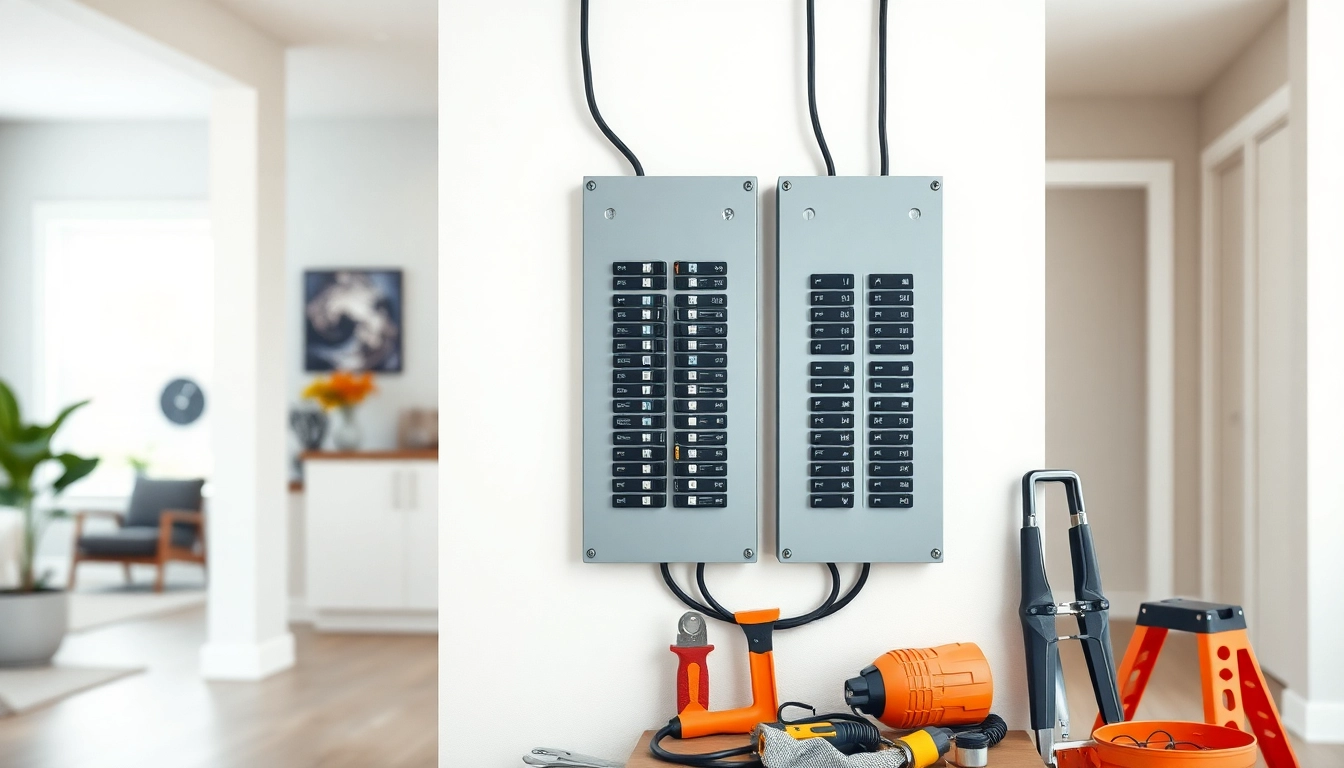Understanding Electrical Panel Upgrade
An electrical panel, often referred to as a circuit breaker panel or electrical service panel, plays a critical role in distributing electricity throughout your home. It serves as the central hub of your electrical system, managing incoming power from the utility company and redistributing it to various circuits powering your appliances, lights, and outlets. Over time, homeowners may consider an Electrical Panel Upgrade to enhance safety, improve efficiency, or accommodate increased energy demands.
What is an Electrical Panel Upgrade?
An electrical panel upgrade involves replacing or modernizing your existing panel to improve its capacity, functionality, and safety features. This can include upgrading to a higher amperage panel, replacing outdated components, and installing new circuit breakers. A typical upgrade might involve transitioning from a 100-amp panel to a 200-amp panel, which allows for more electrical power to be distributed throughout the home. This upgrade is particularly vital for homes that require more electricity for new appliances, electric vehicles, or home automation systems.
Signs You Need an Electrical Panel Upgrade
Identifying the right time to upgrade your electrical panel can help prevent safety hazards and ensure your home’s electrical system runs efficiently. Here are common signs indicating that an upgrade might be necessary:
- Frequent Circuit Breaker Trips: If you experience frequent tripping, it may signify that your panel cannot handle the electrical load.
- Flickering Lights: If lights flicker or dim when using multiple appliances, this could indicate inadequate power distribution.
- Overheating or Burning Smells: Any signs of burnt wires or overheating around the panel are significant safety hazards.
- Older Panel Models: If your panel is over 20 years old, it may not meet current safety and performance standards.
- Increased Electrical Load: Major home renovations or the addition of powerful appliances may require additional capacity.
- Non-GFCI Outlets in Wet Areas: If your kitchen or bathroom does not have Ground Fault Circuit Interrupter (GFCI) outlets, this could pose a safety risk.
Benefits of Upgrading Your Electrical Panel
Upgrading your electrical panel can lead to numerous advantages that contribute to improved safety and functionality in your home:
- Increased Capacity: Higher amperage can accommodate additional electrical devices, ensuring a safe and efficient supply of power.
- Improved Safety: Modern panels come with better protective features to reduce risks, such as electrical fires or shocks.
- Enhanced Home Value: An updated electrical system can increase your home’s resale value and attractiveness to potential buyers.
- Energy Efficiency: Newer technology offers improved energy management, leading to potential savings on electricity bills.
- Future-Proofing: Preparing for future technological advancements, such as home automation or electric vehicle charging, ensures your electrical system meets future demands.
Cost Factors of an Electrical Panel Upgrade
Average Costs and Pricing Breakdown
The cost of upgrading an electrical panel can vary significantly based on several factors, including panel type, location, and the complexity of the installation. On average, homeowners may expect to spend between $800 to $4,000. Here are some elements influencing the overall cost:
- Type of Panel: Upgrading from a 100-amp to a 200-amp panel typically incurs higher costs due to the additional hardware required.
- Labor Rates: Electricians may charge between $50 and $120 per hour based on their expertise and regional rates.
- Permits and Inspections: Local regulations may necessitate permits that can add to your overall expenses.
- Additional Electrical Work: If the upgrade requires additional wiring or circuit installations, costs can escalate.
Hidden Costs to Consider
When budgeting for an electrical panel upgrade, it’s crucial to account for potential hidden costs that may arise:
- Panel Accessories: Circuit breakers, wiring, and shut-off devices can add to the total expense.
- Upgrades to the Main Service Line: If your current service line lacks sufficient capacity, it may need replacement.
- Unforeseen Repairs: Issues with outdated wiring or concealed damage can surface during the upgrade, necessitating additional work.
- Post-Upgrade Inspection: Regular inspections are advisable post-upgrade to ensure ongoing safety and compliance.
Financing Options for Electrical Panel Upgrade
For homeowners concerned about the expenses associated with upgrading their electrical panels, several financing avenues can alleviate financial pressure:
- Home Equity Loans: Utilizing home equity can provide funds for your upgrade, often at lower interest rates.
- Personal Loans: Unsecured personal loans can offer quick access to funds for smaller projects.
- Credit Cards: Using a credit card with a promotional interest rate may help manage upfront costs.
- State and Federal Incentives: Research available rebates, tax credits, or promotional programs supporting electrical upgrades.
Choosing the Right Professional for Your Electrical Panel Upgrade
How to Select a Qualified Electrician
Choosing a qualified electrician for your upgrade is essential for ensuring quality work and compliance with local codes. Here are steps to help in your selection process:
- Check Credentials: Ensure the electrician is licensed, insured, and has the necessary certifications for electrical work.
- Experience Matters: Look for electricians with specific experience in panel upgrades, as this specialization can greatly impact the quality of work.
- Read Reviews: Online reviews and testimonials offer insights into previous clients’ experiences and satisfaction levels.
- Referrals: Personal recommendations from friends or family can lead to trustworthy professionals.
Questions to Ask Before Hiring
Before finalizing your choice of electrician, consider asking the following questions to gauge their suitability:
- What is the estimated cost, including labor and materials?
- Do you provide a warranty for your work?
- How long will the project take to complete?
- Will you handle the permits and inspections?
- Can you provide references from past clients?
Evaluating Quotes and Services
Once you’ve gathered multiple quotes, evaluate them carefully. Look beyond the total cost to consider the scope of work, included materials, and service guarantees. Comparing different electricians on their approach to the project can also provide insights into their commitment to customer service and workmanship quality.
Regulations and Permits for Electrical Panel Upgrade
Understanding Local Codes and Compliance
Upgrading your electrical panel must comply with local building codes and regulations designed to ensure safety and reliability. Understanding these codes is crucial to avoid potential safety hazards and legal issues:
- National Electrical Code (NEC): Most jurisdictions follow the NEC guidelines, establishing safety protocols for electrical installations.
- Local Amendments: Some areas may have additional codes or amendments to the NEC, so familiarize yourself with local requirements.
Importance of Permits in Your Upgrade
Securing the necessary permits before beginning the upgrade process is critical. Permits help ensure that all work meets safety codes and is verified by local inspectors. This process not only protects your investment but also ensures that your electrical system operates efficiently and safely.
Potential Legal Issues Without Proper Authorization
Failing to obtain the required permits can lead to serious legal and financial consequences, including:
- Fines and Penalties: Many municipalities impose fines for unauthorized work.
- Increased Liability: In the event of an electrical failure or fire, lack of permits can result in liability issues for homeowners.
- Difficulty Selling Your Home: Inspections may reveal unpermitted work, complicating the sale process.
After the Electrical Panel Upgrade: Next Steps
Regular Maintenance Tips Post-Upgrade
After completing your electrical panel upgrade, establish a maintenance routine to ensure long-term functionality and safety:
- Regular Inspections: Schedule annual inspections with a licensed electrician to catch potential issues early.
- Keep Panels Accessible: Ensure that the panel area is free from clutter or obstructions.
- Monitor for Issues: Stay vigilant for any signs of malfunction, such as flickering lights or unusual sounds.
Adapting to Increased Power Capacity
An upgraded panel may allow for greater energy demands, potentially enabling you to introduce new appliances or technologies. Be mindful of electrical load management to ensure efficient and safe operation. Understanding the load duty of devices can help prevent overloading circuits.
Long-term Benefits of an Upgraded Panel
Investing in an electrical panel upgrade not only addresses immediate electrical needs but also secures multiple long-term advantages. Enhanced safety, reduced risk of equipment damage, and improved energy efficiency can contribute to a more reliable and technologically advanced living environment.
Ultimately, the decision to upgrade your electrical panel is a proactive step toward ensuring a safe, efficient, and modern electrical system within your home. This investment can yield significant benefits for both your current living situation and future property value, making it a worthwhile consideration for any homeowner.















Leave a Reply